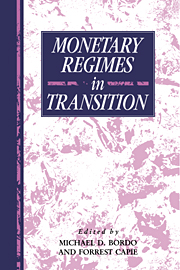Book contents
- Frontmatter
- Contents
- List of figures
- List of tables
- List of contributors
- 1 Introduction
- Part I Commodity money standards in transition
- Part II Successful and unsuccessful adherence to the gold standard
- 5 Spain during the classical gold standard years, 1880–1914
- 6 Canada and the gold standard, 1871–1914: a durable monetary regime
- 7 Australia's payments adjustment and capital flows under the international gold standard, 1870–1913
- Part III Wartime upheaval and postwar stabilization
- Part IV Perspectives on monetary regimes
- Index
7 - Australia's payments adjustment and capital flows under the international gold standard, 1870–1913
Published online by Cambridge University Press: 05 May 2010
- Frontmatter
- Contents
- List of figures
- List of tables
- List of contributors
- 1 Introduction
- Part I Commodity money standards in transition
- Part II Successful and unsuccessful adherence to the gold standard
- 5 Spain during the classical gold standard years, 1880–1914
- 6 Canada and the gold standard, 1871–1914: a durable monetary regime
- 7 Australia's payments adjustment and capital flows under the international gold standard, 1870–1913
- Part III Wartime upheaval and postwar stabilization
- Part IV Perspectives on monetary regimes
- Index
Summary
Introduction
While much has been written about the international gold standard and how it functioned for major economies in the five decades or so before 1914, little detailed work has been done on the so-called “peripheral” countries like Australia. A study of Australia presents some interesting contrasts to the “core” countries, in that she was a major gold producer and continued on gold in the face of internal disequilibrium of gigantic proportions (20-25 percent of Australia's workforce being unemployed in the 1890s). This chapter examines how the exchange rate was determined and the role of automatic adjustments to the balance of payments through capital flows.
Australian economists in the 1920s and 1930s (and economic historians since) dismissed specie movements as the equilibrator of payments because these depended on bankers’ need for coin, rather than the exchange rate. Instead, Australian writers espoused a regulatory mechanism in which bankers played the crucial role. Under this “managed exchange standard,” external disequilibrium was corrected by banks altering their (domestic) credit and permitting their foreign reserves to fluctuate in accord with the balance of payments. There has been no attempt empirically to verify such assertions, or to test old and modern theories of payments adjustment.
This chapter examines the adjustment process through an intercountry portfolio equilibrium model founded on the monetary approach to the balance of payment (MABP), as well as through the traditional Humean dynamics of the classical price-specie-flow mechanism (PSF). The role of Australia's bankers is also appraised.
- Type
- Chapter
- Information
- Monetary Regimes in Transition , pp. 201 - 238Publisher: Cambridge University PressPrint publication year: 1993
- 1
- Cited by



